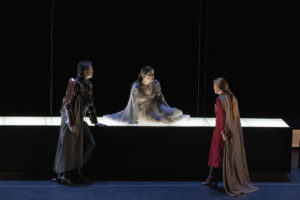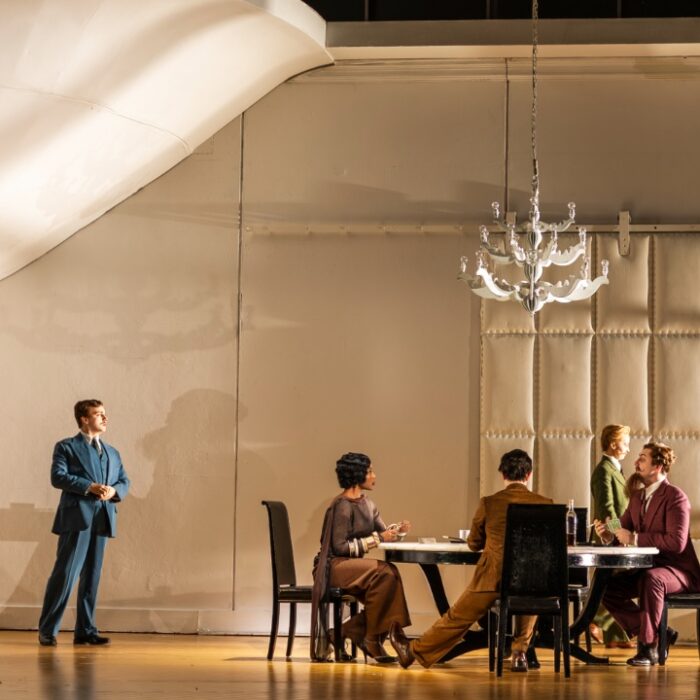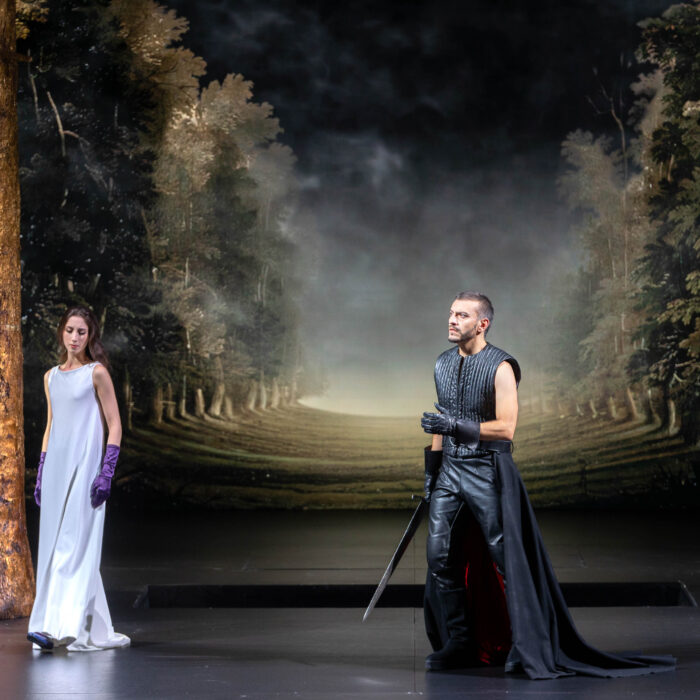
Teatro Comunale di Ferrara 2021-22 Review: Farnace
Vivaldi’s Opera Finally Receives A Performance In The City Which Originally Banned It 283 Years Ago
By Alan Neilson(Photo: Marco Caselli)
In 1739 Vivaldi complained in a letter to his patron Marquis Guido Bentivoglio about the treatment he had suffered from the directors of Ferrara’s Teatro Bonacossi: “My reputation has been scourged…to the extent they are refusing as a second opera ‘Farnace,’ which I have prepared afresh especially for the company according to written agreements… I will not tolerate such offenses.”
The theatre’s decision may appear to be a strange one, given that “Farnace” was one of the composer’s most popular operas, having received numerous revivals since its premiere at Venice’s Teatro Sant’Angelo in 1727. However, the theatre’s decision had not been taken on artistic grounds. Rather Vivaldi, who was an ordained priest, had run foul of Cardinal Ruffo, whose sensitivities had been offended by the strong rumors of the composer’s intimate relationship with the singer Anna Girò, and had subsequently banned the performance.
Vivaldi made extensive alterations to the score for Ferrara, amounting to a thorough reworking of the existing arias and recitatives, as well as the addition of eight new arias, although whether he completed the task is unknown, as only the first two of the three acts have been found. It is possible that Act three has been lost or, owing to Ruffo’s intervention, Vivaldi might simply have abandoned the revision. Either way, the version was shelved and he was never to see it performed. He died two years later in Vienna.
Now, 283 years later, Ferrara’s Teatro Comunale has brought this revised version of “Farnace” back to the city for which it had been written, albeit in its truncated form. There was no attempt to either tack on, or to reconstruct an Act three from an earlier version, as Diego Fasolis did for his excellent 2011 recording.
Act two ends with Farnace, King of Pontus, discovering that his son has not been killed as he had ordered, and a reconciliation of sorts takes place, but he rejects his wife for failing to kill herself and their son. This leaves huge questions left hanging in the air as to what will now happen to Farnace, his son, his wife, and his country, and without the lieto fine of Act three, a negative impression of Farnace’s behavior as cruel and egotistical is inevitable. However, audience’s are now used to dramas ending without everything being neatly concluded, which allows space for their own imaginations to speculate on what might be. In this respect, therefore, the loss of Act three did not prove overly detrimental to the theatrical experience at all.
Solid Direction With The Composer’s Own Input
Marco Bellussi, responsible for the stage direction, was aided by scenographer Matteo Paoletti Franzato, costume designer Carlos Tieppo, and lighting designer Marco Cazzola. Together they created an atmospheric presentation which captured the violence, deep lying hatreds and bitterness which underlie the drama. The stage was for the most part fairly empty, relying for long periods on a large table or platform in the centre with only the occasional prop, such as a chair or mirror. It was all very basic, but effective in focusing the attention on the interaction between the characters.
Dark lighting was used sensitively to create a bleak, heavy atmosphere, with the addition of occasional colored lighting across the back frieze to bring the necessary contrast, so as to ensure that the visual effect was never monotonous.
The costumes were not time specific, although they were suggestive of the ancient world. Moreover, they were very pleasing on the eye. They were colorful, imaginative and, importantly, they successfully reflected the status and personality of the characters.
Bellusi was guided by Vivaldi’s own staging instructions and interpretive notations for the singers which have been preserved in the Ferrara manuscript. This provided the production with elements of historical performing practices, apparent in the occasional use of exaggerated poses, but the overall aesthetic was that of a modern day presentation.
Bellusi’s imaginative use of static poses for the supporting actors provided an added visual dimension, while also highlighting significant elements of the relationship between the characters. Scenes were balanced and well-constructed and successfully conveyed the drama, with Selinda’s seduction scenes being particularly effective.
A Formidable Performance From Pe
There were a number very good singing performances, not least from the countertenor Raffaele Pe who was formidable in the role of Farnace. His singing was clear and forceful, detailed and expressive. However, it was his ability to capture Farnace’s complex character as an energetic, impetuous leader, who was captive to his own sense of honor and strong emotions which stood out.
Recitatives were expertly crafted to highlight his determination, and his arias brought out the depth of Farnace’s passions. In his first aria “Ricordati che sei” he reminds his wife of her duties as a Queen. Singing with force and energy, he managed the vocal line so as to infuse it with an abundance of detail, full of embellishments in which his agile coloratura sparkled.
In the aria “Perdona o figlio e fremo” Farnace, realising his son still lives, asks for forgiveness, for which he produced a sensitive rendition coating his long lines with heartfelt pain. Whilst in “Gemo in un punto e fremo” his vocal agility is once again brilliantly on display as he allows emotions run wild in an extended passage of florid vocal ravings, underpinned by fine vocal control.
Strong Supporting Cast
The mezzo-soprano/contralto Chiara Brunello gave an expressive performance in the role of Tamiri, in which the beguiling soft textures and dark colors of her voice captured the attention. Recitatives were intelligently crafted and purposefully delivered, allowing for the development of convincing relationships with the other characters, especially Farnace.
Arias were well-sung. Her opening aria “Comabattono quest’alma” was given a passionate rendition in which her ability to characterize Tamiri’s anxiety and horror at having to kill her son were clearly expounded. Towards the end of Act one she confronts Pompeo and taunts him in the aria “Or di Roma forti eroi.” Singing with a confident swagger in the voice, it enabled Brunello to show off her neatly formed phrasing with its subtle dynamic and colorful contrasts.
Soprano Francesca Lombardi Mazzulli was excellent in the role of the Berenice’s army captain Gilade. She possesses a strong, agile voice which she employed skilflully to characterize her role. Moreover, it was a performance which highlighted the quality of her singing with three beautifully delivered arias, the most impressive of which was “Quell’usignolo che innamorato,” which ponders on the cruelty of unreturned love, using a nightingale as a metaphor. Each line was exquisitely crafted, full of subtle dynamic and colorful inflections, of which her mimicking of the nightingale was delightfully painted with gentle coloraturas and birdlike trilling. Recitatives were equally accomplished.
Elena Biscuola produced a clearly defined reading of Berenice. She was vicious, unforgiving and determined to have her revenge on Farnace. However, although she produced a solid, colorful singing presentation, her vocal characterization was compromised by weakness in the upper register, and her accenting of the vocal line lacked sharpness and vitality which deadened the impact, to the extent they, at times, sounded one-paced, even mechanical. Recitatives were well crafted, and underpinned by strongly expressed emotions.
Tenor Leonardo Cortellazzi gave a authoritative performance in the role of Pompeo, capturing the statesman’s dignity and air of superiority. His singing was expressive, whilst always exuding a degree of elegance and a grandeur befitting his rank as a Roman general. His singing was strong across the range, and his phrasing was beautifully woven which he nicely illustrated in his aria “Non trema senza stella” which brought Act one to an end. Against a background of a lively orchestral accompaniment he subtly embellished the vocal line and displayed a pleasing coloratura in an energetic presentation, but one which he ensured never compromised Pompeo’s composure.
Farnace’s sister Selinda was played by mezzo-soprano Silvia Alice Gianolla, who produced an excellent portrait of a seductress, who knowingly uses her sexuality to aid Farnace, although vocally she was rather conservative in her presentation of her only aria “Lascias di sospirar!” However, her recitatives displayed depth and detail and were delivered with a high degree of expressivity.
Baritone Mauro Borgioni produced a well-sung performance in the role of the prefect of Rome Aquilio in which his distinctive, warm timbre caught the attention. His voice has strength and depth, which he used skillfully to characterize his role. The aria “Alle minaccia di fiera belva” showed off his vocal agility to good effect, in which his detailed and intelligently crafted phrasing impressed. Recitatives were confidently delivered with meaning and nuance.
It was left to Borgioni and Gianolla to bring the opera to its premature end with the duet “Io sento nel petto,” which they delivered with a fluorish, their voices neatly complementing each other.
Although having only a small role, the Coro Accademia Dello Spirito Santo under the guidance of Chorusmaster Francesco Pinamonti produced a strong performance. The short chorus “Su campioni, su guerrieri” to a brass accompaniment, in particular, was dramatically strong.
Vivaldi specialist Federico Maria Sardelli took charge of the Orchestra Accademia Dello Spirito Santo, from which he elicited a superb performance. It was elegant and refined, yet with a rhythmic vitality that successfully promoted the drama. The balance within the orchestra was expertly maintained, and successfully revealed the score’s delicate textures. Likewise the balance with the stage was in perfect accord, in which neither was allowed to predominate.
In many ways this production of “Farnace,” shorn of its third act, could well have be seen as an academic exercise, one for the Vivaldi enthusiasts, a chance to see the composers final, albeit incomplete, version of one his most popular operas. As it turned out, however, it proved to be far more than that. It was dramatically coherent, and in certain respects the loose ends added to the drama. Certainly, there have been productions of complete versions of “Farnace” which have proved far less satisfactory, La Fenice’s 2021 production, also conducted by Sardelli, springs to mind.



